Business Expansion Research Project: Graze's Global Strategy Analysis
VerifiedAdded on 2023/01/16
|20
|2927
|84
Project
AI Summary
This research project focuses on Graze's potential for global expansion, analyzing various aspects of international business strategy. The project begins with an introduction to the methodology used, including cost considerations, sampling design (20 respondents from Graze's upper management), primary data collection through self-questionnaires, data collection administration, and the data analysis approach. The results section presents the findings from the survey data, interpreted using statistical tools and presented in graphical form. Key themes include respondents' familiarity with globalization, the main reasons for Graze to globalize, suitable entry modes (franchising, licensing, direct investment, joint ventures), the most suitable emerging markets (South Africa, Malaysia), the perceived impact of globalization, the benefits of globalization, potential barriers, ways to reduce negative impacts, and the role of product development. The project concludes with a summary of findings, emphasizing the benefits of globalization for companies like Graze, and offers recommendations for market entry modes and strategic planning to address potential challenges such as cultural differences and capital requirements.

Research Project
Paraphrase This Document
Need a fresh take? Get an instant paraphrase of this document with our AI Paraphraser
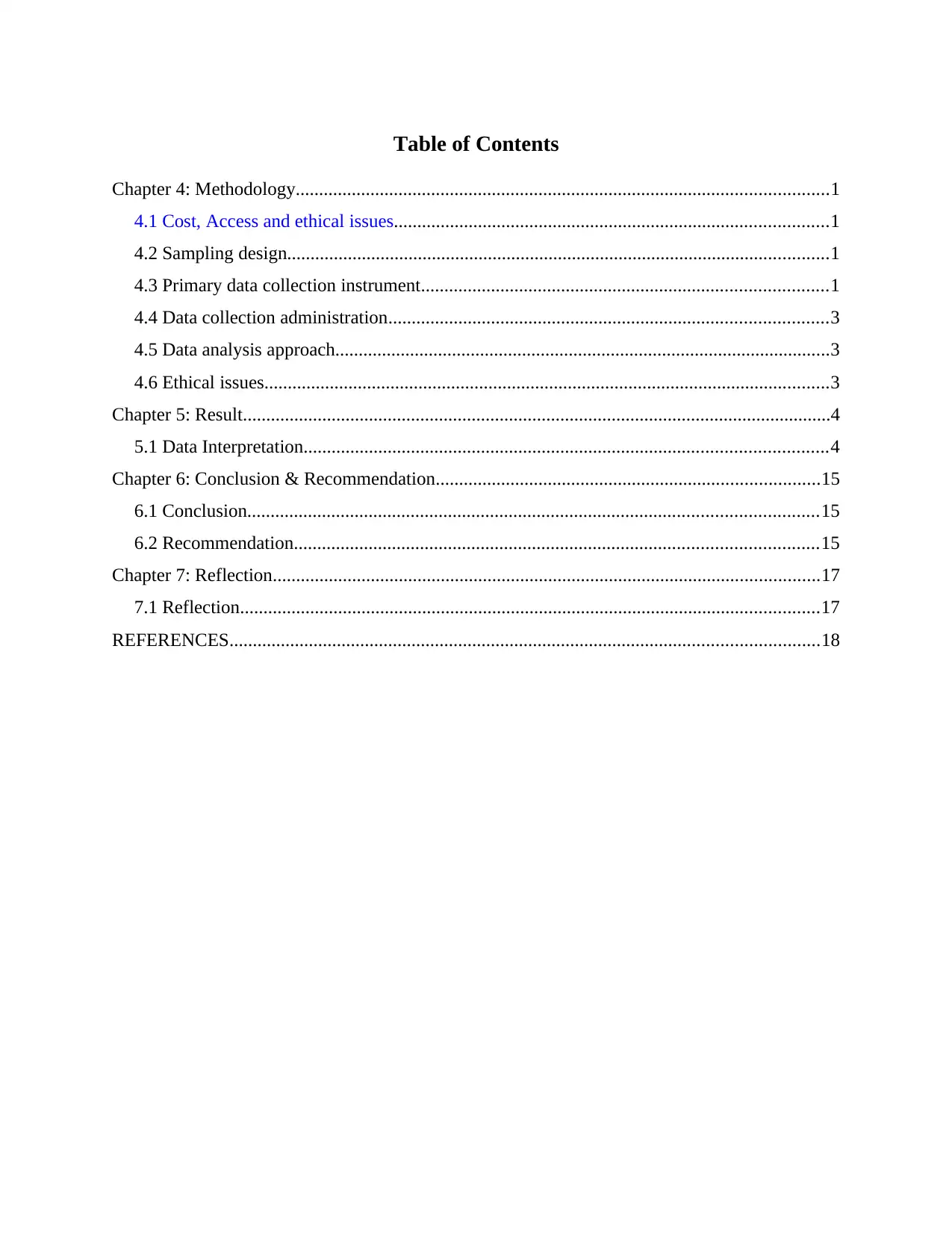
Table of Contents
Chapter 4: Methodology..................................................................................................................1
4.1 Cost, Access and ethical issues.............................................................................................1
4.2 Sampling design....................................................................................................................1
4.3 Primary data collection instrument.......................................................................................1
4.4 Data collection administration..............................................................................................3
4.5 Data analysis approach..........................................................................................................3
4.6 Ethical issues.........................................................................................................................3
Chapter 5: Result..............................................................................................................................4
5.1 Data Interpretation................................................................................................................4
Chapter 6: Conclusion & Recommendation..................................................................................15
6.1 Conclusion..........................................................................................................................15
6.2 Recommendation................................................................................................................15
Chapter 7: Reflection.....................................................................................................................17
7.1 Reflection............................................................................................................................17
REFERENCES..............................................................................................................................18
Chapter 4: Methodology..................................................................................................................1
4.1 Cost, Access and ethical issues.............................................................................................1
4.2 Sampling design....................................................................................................................1
4.3 Primary data collection instrument.......................................................................................1
4.4 Data collection administration..............................................................................................3
4.5 Data analysis approach..........................................................................................................3
4.6 Ethical issues.........................................................................................................................3
Chapter 5: Result..............................................................................................................................4
5.1 Data Interpretation................................................................................................................4
Chapter 6: Conclusion & Recommendation..................................................................................15
6.1 Conclusion..........................................................................................................................15
6.2 Recommendation................................................................................................................15
Chapter 7: Reflection.....................................................................................................................17
7.1 Reflection............................................................................................................................17
REFERENCES..............................................................................................................................18

Chapter 4: Methodology
4.1 Cost, Access and ethical issues
In order to conduct primary survey, employees of Graze are chosen as respondents,
where before any survey, a consent form will be signed with them, to ensure them any personal
information will not be disclosed during and after the research. While for conducting both
primary and secondary research, near about £150 is estimated, where for completing each
activity, proper budget is prepared.
4.2 Sampling design
For conducting primary survey, 20 respondents are chosen from upper management team
of Graze including operation department, marketing, HR and more, by random selection
technique, where all get equal opportunity for being selected in the research.
4.3 Primary data collection instrument
To conduct primary survey, self-questionnaire method is chosen where relevant questions
based on the given topic are made as shown below -
Questionnaire
Q1) Are you familiar with the role of globalisation in business expansion?
a) Yes
b) No
Q2) What are the main reason of Graze for globalising its business at international market?
a) To increase market share
b) To maximise the customer base
c) To increase the brand mage
Q3) Which entry modes strategy Graze can adopt for enter into global market?
a) Franchising
b) Licensing
c) Direct Investment
d) Joint venture
Q4) Which emerging market is suitable to Graze for globalising its business?
a) South Africa
1
4.1 Cost, Access and ethical issues
In order to conduct primary survey, employees of Graze are chosen as respondents,
where before any survey, a consent form will be signed with them, to ensure them any personal
information will not be disclosed during and after the research. While for conducting both
primary and secondary research, near about £150 is estimated, where for completing each
activity, proper budget is prepared.
4.2 Sampling design
For conducting primary survey, 20 respondents are chosen from upper management team
of Graze including operation department, marketing, HR and more, by random selection
technique, where all get equal opportunity for being selected in the research.
4.3 Primary data collection instrument
To conduct primary survey, self-questionnaire method is chosen where relevant questions
based on the given topic are made as shown below -
Questionnaire
Q1) Are you familiar with the role of globalisation in business expansion?
a) Yes
b) No
Q2) What are the main reason of Graze for globalising its business at international market?
a) To increase market share
b) To maximise the customer base
c) To increase the brand mage
Q3) Which entry modes strategy Graze can adopt for enter into global market?
a) Franchising
b) Licensing
c) Direct Investment
d) Joint venture
Q4) Which emerging market is suitable to Graze for globalising its business?
a) South Africa
1
⊘ This is a preview!⊘
Do you want full access?
Subscribe today to unlock all pages.

Trusted by 1+ million students worldwide

b) Malaysia
c) others
Q5) According to you, how globalisation would impact on business activities of Graze in
international market?
a) Positive
b) Negative
Q6) What are the main benefits of globalisation that Graze can gain by moving its business in
international market?
a) Increased customer base
b) Greater competition
c) Improvement in organisational activities
d) Free movement of labour
Q7) What are the barriers that Graze can face while globalising its business?
a) Shortage of manpower
b) Lack of capital source
c) Interference of Government
Q8) How negative impact of globalisation can be reduced on business activities?
a) Improve organisation culture
b) Product development
c) Implementation of new technologies
Q9) Do you think that product development will help Graze in attracting new customers at
global market?
a) Strongly Agree
b) Agree
c) Disagree
d) Strongly Disagree
Q10) Do you think that globalising business will prove beneficial for Graze in generating high
revenue?
a) Yes
b) No
Q11) Provide some recommendation for strategies that Graze can adopt for globalising its
2
c) others
Q5) According to you, how globalisation would impact on business activities of Graze in
international market?
a) Positive
b) Negative
Q6) What are the main benefits of globalisation that Graze can gain by moving its business in
international market?
a) Increased customer base
b) Greater competition
c) Improvement in organisational activities
d) Free movement of labour
Q7) What are the barriers that Graze can face while globalising its business?
a) Shortage of manpower
b) Lack of capital source
c) Interference of Government
Q8) How negative impact of globalisation can be reduced on business activities?
a) Improve organisation culture
b) Product development
c) Implementation of new technologies
Q9) Do you think that product development will help Graze in attracting new customers at
global market?
a) Strongly Agree
b) Agree
c) Disagree
d) Strongly Disagree
Q10) Do you think that globalising business will prove beneficial for Graze in generating high
revenue?
a) Yes
b) No
Q11) Provide some recommendation for strategies that Graze can adopt for globalising its
2
Paraphrase This Document
Need a fresh take? Get an instant paraphrase of this document with our AI Paraphraser
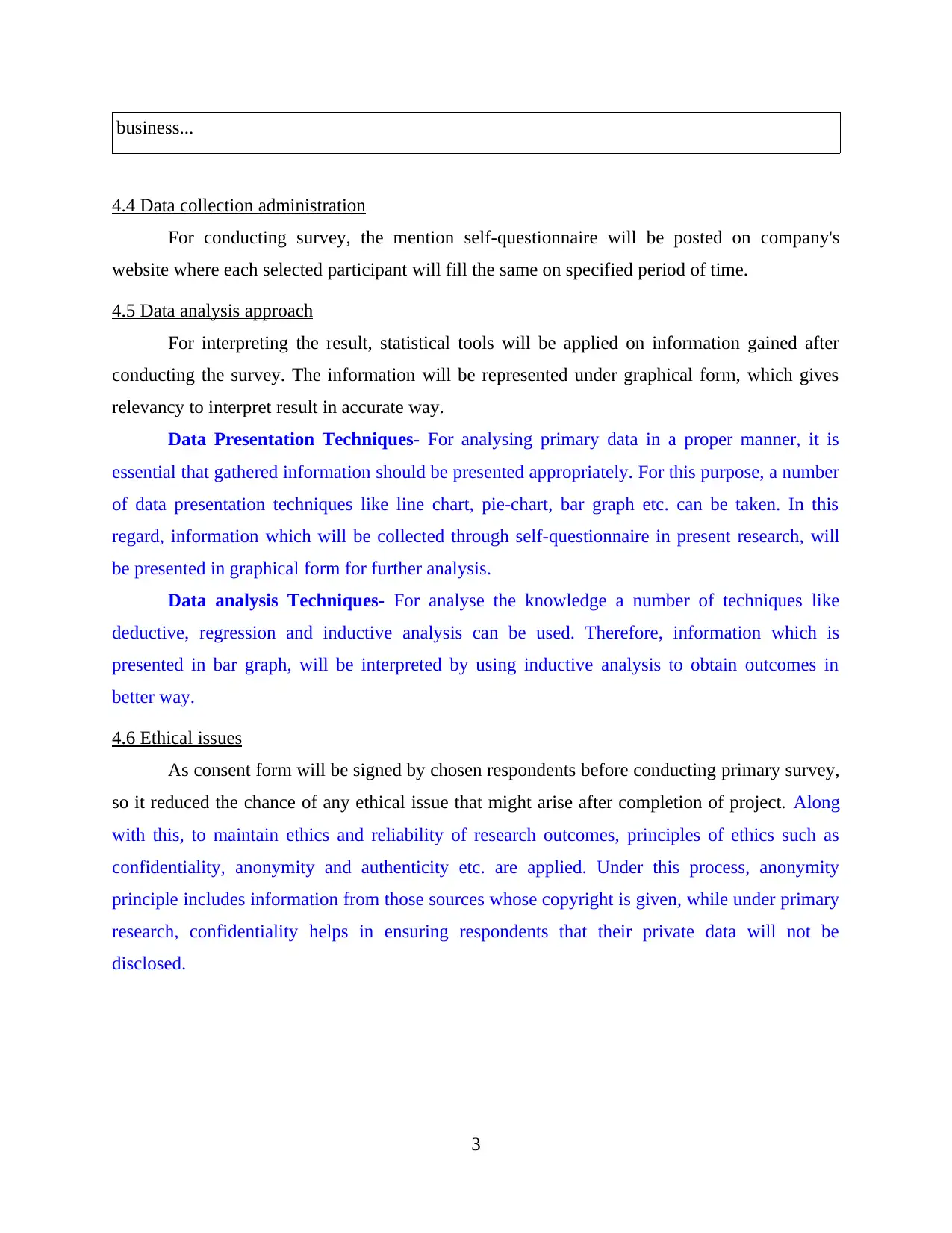
business...
4.4 Data collection administration
For conducting survey, the mention self-questionnaire will be posted on company's
website where each selected participant will fill the same on specified period of time.
4.5 Data analysis approach
For interpreting the result, statistical tools will be applied on information gained after
conducting the survey. The information will be represented under graphical form, which gives
relevancy to interpret result in accurate way.
Data Presentation Techniques- For analysing primary data in a proper manner, it is
essential that gathered information should be presented appropriately. For this purpose, a number
of data presentation techniques like line chart, pie-chart, bar graph etc. can be taken. In this
regard, information which will be collected through self-questionnaire in present research, will
be presented in graphical form for further analysis.
Data analysis Techniques- For analyse the knowledge a number of techniques like
deductive, regression and inductive analysis can be used. Therefore, information which is
presented in bar graph, will be interpreted by using inductive analysis to obtain outcomes in
better way.
4.6 Ethical issues
As consent form will be signed by chosen respondents before conducting primary survey,
so it reduced the chance of any ethical issue that might arise after completion of project. Along
with this, to maintain ethics and reliability of research outcomes, principles of ethics such as
confidentiality, anonymity and authenticity etc. are applied. Under this process, anonymity
principle includes information from those sources whose copyright is given, while under primary
research, confidentiality helps in ensuring respondents that their private data will not be
disclosed.
3
4.4 Data collection administration
For conducting survey, the mention self-questionnaire will be posted on company's
website where each selected participant will fill the same on specified period of time.
4.5 Data analysis approach
For interpreting the result, statistical tools will be applied on information gained after
conducting the survey. The information will be represented under graphical form, which gives
relevancy to interpret result in accurate way.
Data Presentation Techniques- For analysing primary data in a proper manner, it is
essential that gathered information should be presented appropriately. For this purpose, a number
of data presentation techniques like line chart, pie-chart, bar graph etc. can be taken. In this
regard, information which will be collected through self-questionnaire in present research, will
be presented in graphical form for further analysis.
Data analysis Techniques- For analyse the knowledge a number of techniques like
deductive, regression and inductive analysis can be used. Therefore, information which is
presented in bar graph, will be interpreted by using inductive analysis to obtain outcomes in
better way.
4.6 Ethical issues
As consent form will be signed by chosen respondents before conducting primary survey,
so it reduced the chance of any ethical issue that might arise after completion of project. Along
with this, to maintain ethics and reliability of research outcomes, principles of ethics such as
confidentiality, anonymity and authenticity etc. are applied. Under this process, anonymity
principle includes information from those sources whose copyright is given, while under primary
research, confidentiality helps in ensuring respondents that their private data will not be
disclosed.
3
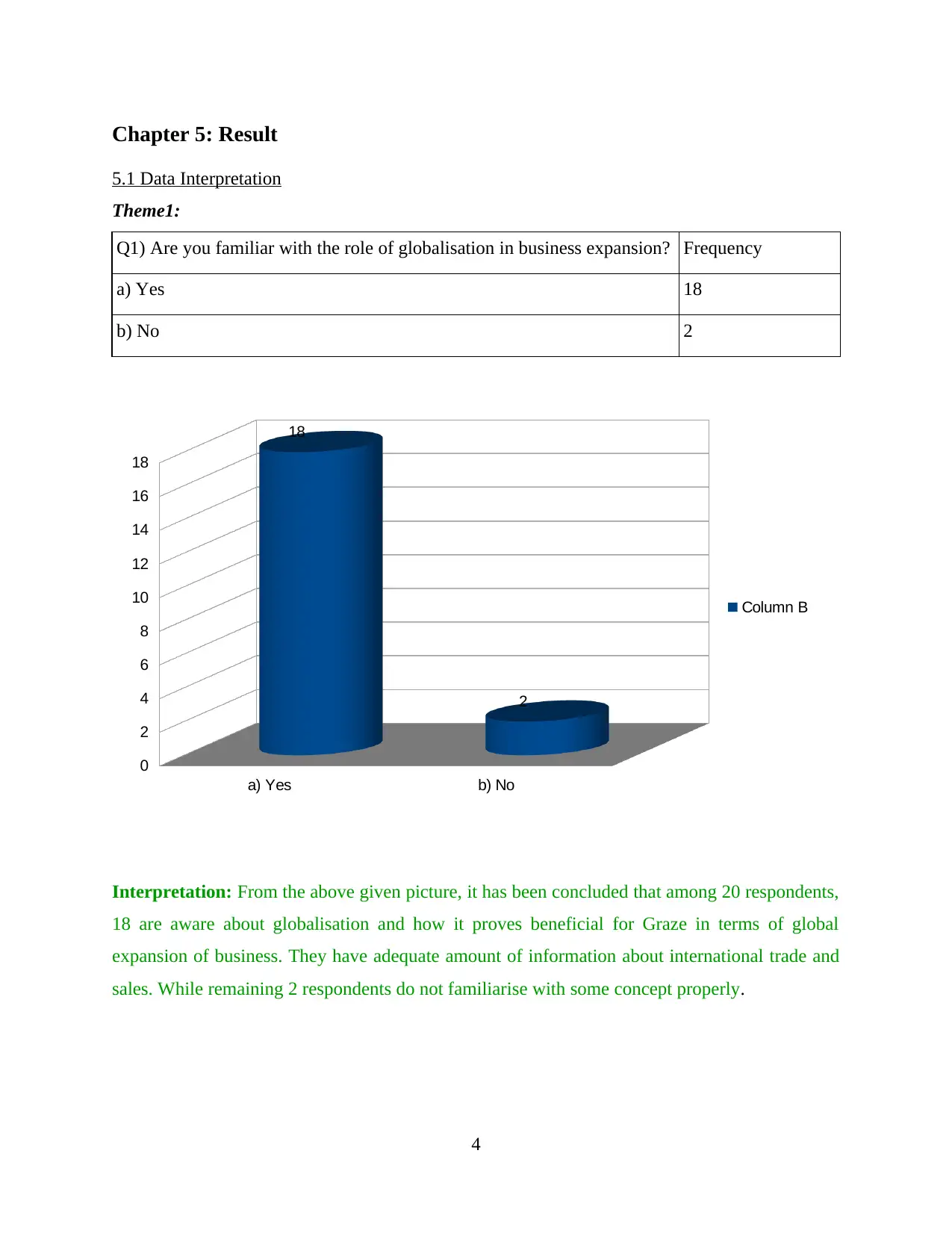
Chapter 5: Result
5.1 Data Interpretation
Theme1:
Q1) Are you familiar with the role of globalisation in business expansion? Frequency
a) Yes 18
b) No 2
Interpretation: From the above given picture, it has been concluded that among 20 respondents,
18 are aware about globalisation and how it proves beneficial for Graze in terms of global
expansion of business. They have adequate amount of information about international trade and
sales. While remaining 2 respondents do not familiarise with some concept properly.
4
a) Yes b) No
0
2
4
6
8
10
12
14
16
18
18
2
Column B
5.1 Data Interpretation
Theme1:
Q1) Are you familiar with the role of globalisation in business expansion? Frequency
a) Yes 18
b) No 2
Interpretation: From the above given picture, it has been concluded that among 20 respondents,
18 are aware about globalisation and how it proves beneficial for Graze in terms of global
expansion of business. They have adequate amount of information about international trade and
sales. While remaining 2 respondents do not familiarise with some concept properly.
4
a) Yes b) No
0
2
4
6
8
10
12
14
16
18
18
2
Column B
⊘ This is a preview!⊘
Do you want full access?
Subscribe today to unlock all pages.

Trusted by 1+ million students worldwide
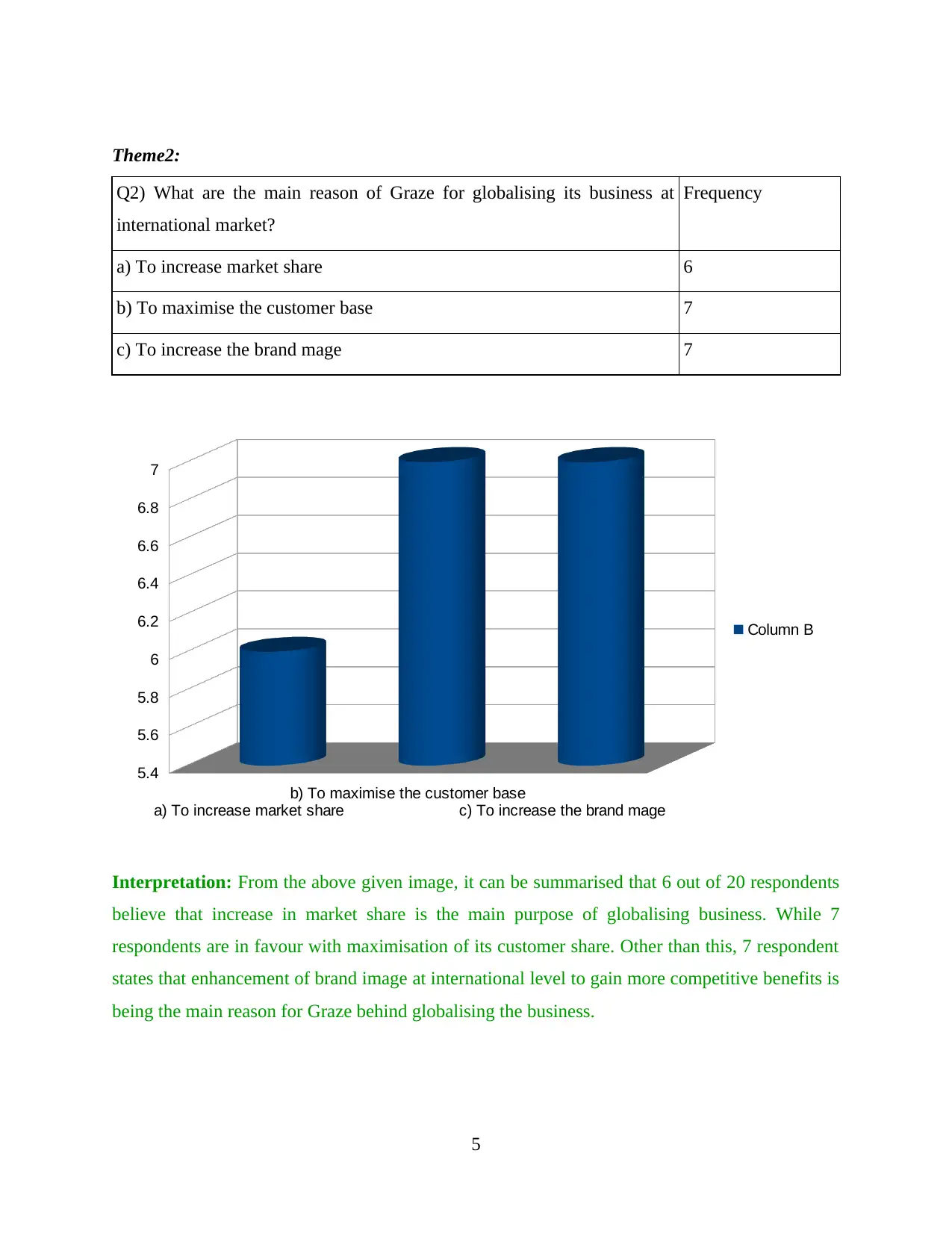
Theme2:
Q2) What are the main reason of Graze for globalising its business at
international market?
Frequency
a) To increase market share 6
b) To maximise the customer base 7
c) To increase the brand mage 7
Interpretation: From the above given image, it can be summarised that 6 out of 20 respondents
believe that increase in market share is the main purpose of globalising business. While 7
respondents are in favour with maximisation of its customer share. Other than this, 7 respondent
states that enhancement of brand image at international level to gain more competitive benefits is
being the main reason for Graze behind globalising the business.
5
a) To increase market share
b) To maximise the customer base
c) To increase the brand mage
5.4
5.6
5.8
6
6.2
6.4
6.6
6.8
7
Column B
Q2) What are the main reason of Graze for globalising its business at
international market?
Frequency
a) To increase market share 6
b) To maximise the customer base 7
c) To increase the brand mage 7
Interpretation: From the above given image, it can be summarised that 6 out of 20 respondents
believe that increase in market share is the main purpose of globalising business. While 7
respondents are in favour with maximisation of its customer share. Other than this, 7 respondent
states that enhancement of brand image at international level to gain more competitive benefits is
being the main reason for Graze behind globalising the business.
5
a) To increase market share
b) To maximise the customer base
c) To increase the brand mage
5.4
5.6
5.8
6
6.2
6.4
6.6
6.8
7
Column B
Paraphrase This Document
Need a fresh take? Get an instant paraphrase of this document with our AI Paraphraser
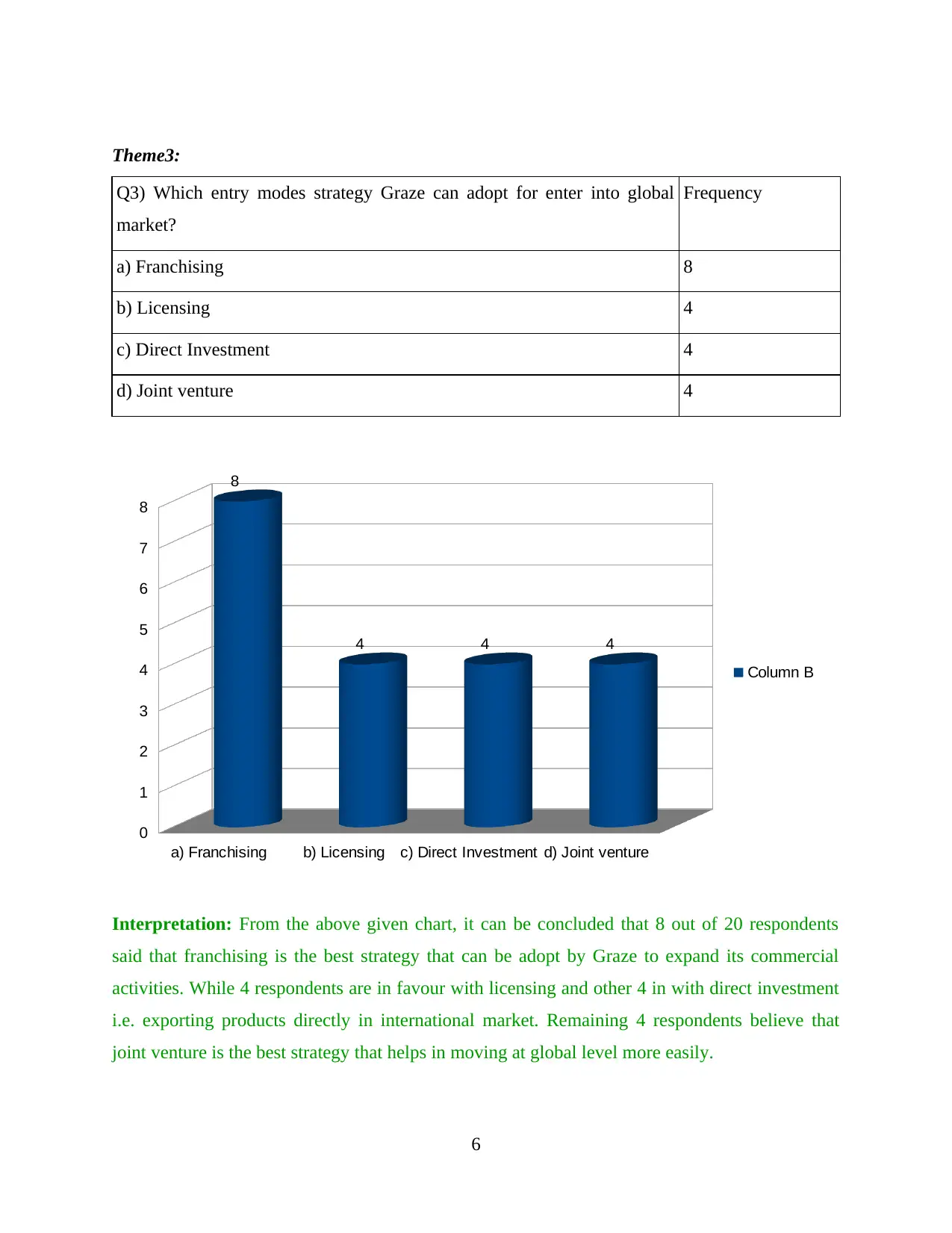
Theme3:
Q3) Which entry modes strategy Graze can adopt for enter into global
market?
Frequency
a) Franchising 8
b) Licensing 4
c) Direct Investment 4
d) Joint venture 4
Interpretation: From the above given chart, it can be concluded that 8 out of 20 respondents
said that franchising is the best strategy that can be adopt by Graze to expand its commercial
activities. While 4 respondents are in favour with licensing and other 4 in with direct investment
i.e. exporting products directly in international market. Remaining 4 respondents believe that
joint venture is the best strategy that helps in moving at global level more easily.
6
a) Franchising b) Licensing c) Direct Investment d) Joint venture
0
1
2
3
4
5
6
7
8
8
4 4 4
Column B
Q3) Which entry modes strategy Graze can adopt for enter into global
market?
Frequency
a) Franchising 8
b) Licensing 4
c) Direct Investment 4
d) Joint venture 4
Interpretation: From the above given chart, it can be concluded that 8 out of 20 respondents
said that franchising is the best strategy that can be adopt by Graze to expand its commercial
activities. While 4 respondents are in favour with licensing and other 4 in with direct investment
i.e. exporting products directly in international market. Remaining 4 respondents believe that
joint venture is the best strategy that helps in moving at global level more easily.
6
a) Franchising b) Licensing c) Direct Investment d) Joint venture
0
1
2
3
4
5
6
7
8
8
4 4 4
Column B
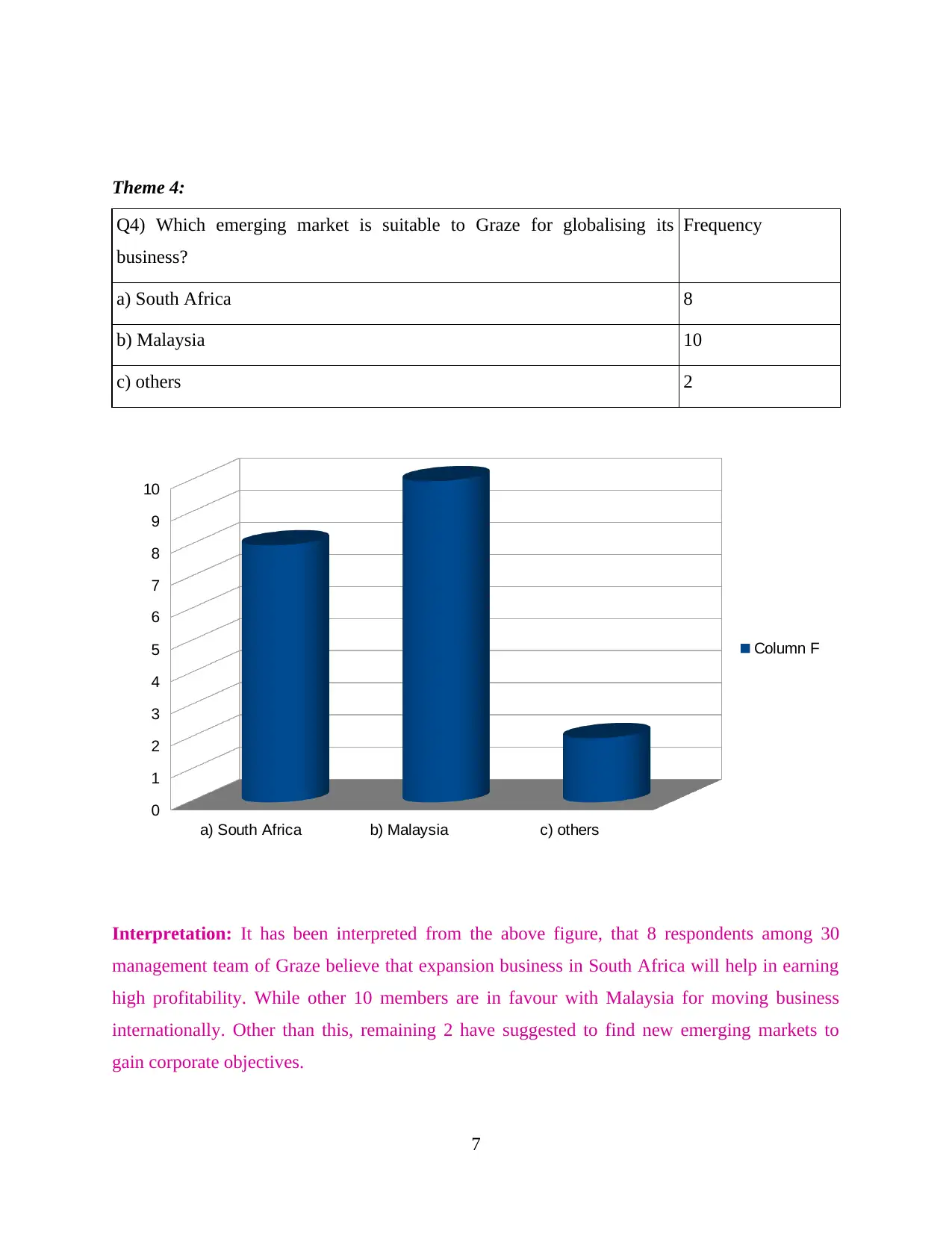
Theme 4:
Q4) Which emerging market is suitable to Graze for globalising its
business?
Frequency
a) South Africa 8
b) Malaysia 10
c) others 2
Interpretation: It has been interpreted from the above figure, that 8 respondents among 30
management team of Graze believe that expansion business in South Africa will help in earning
high profitability. While other 10 members are in favour with Malaysia for moving business
internationally. Other than this, remaining 2 have suggested to find new emerging markets to
gain corporate objectives.
7
a) South Africa b) Malaysia c) others
0
1
2
3
4
5
6
7
8
9
10
Column F
Q4) Which emerging market is suitable to Graze for globalising its
business?
Frequency
a) South Africa 8
b) Malaysia 10
c) others 2
Interpretation: It has been interpreted from the above figure, that 8 respondents among 30
management team of Graze believe that expansion business in South Africa will help in earning
high profitability. While other 10 members are in favour with Malaysia for moving business
internationally. Other than this, remaining 2 have suggested to find new emerging markets to
gain corporate objectives.
7
a) South Africa b) Malaysia c) others
0
1
2
3
4
5
6
7
8
9
10
Column F
⊘ This is a preview!⊘
Do you want full access?
Subscribe today to unlock all pages.

Trusted by 1+ million students worldwide
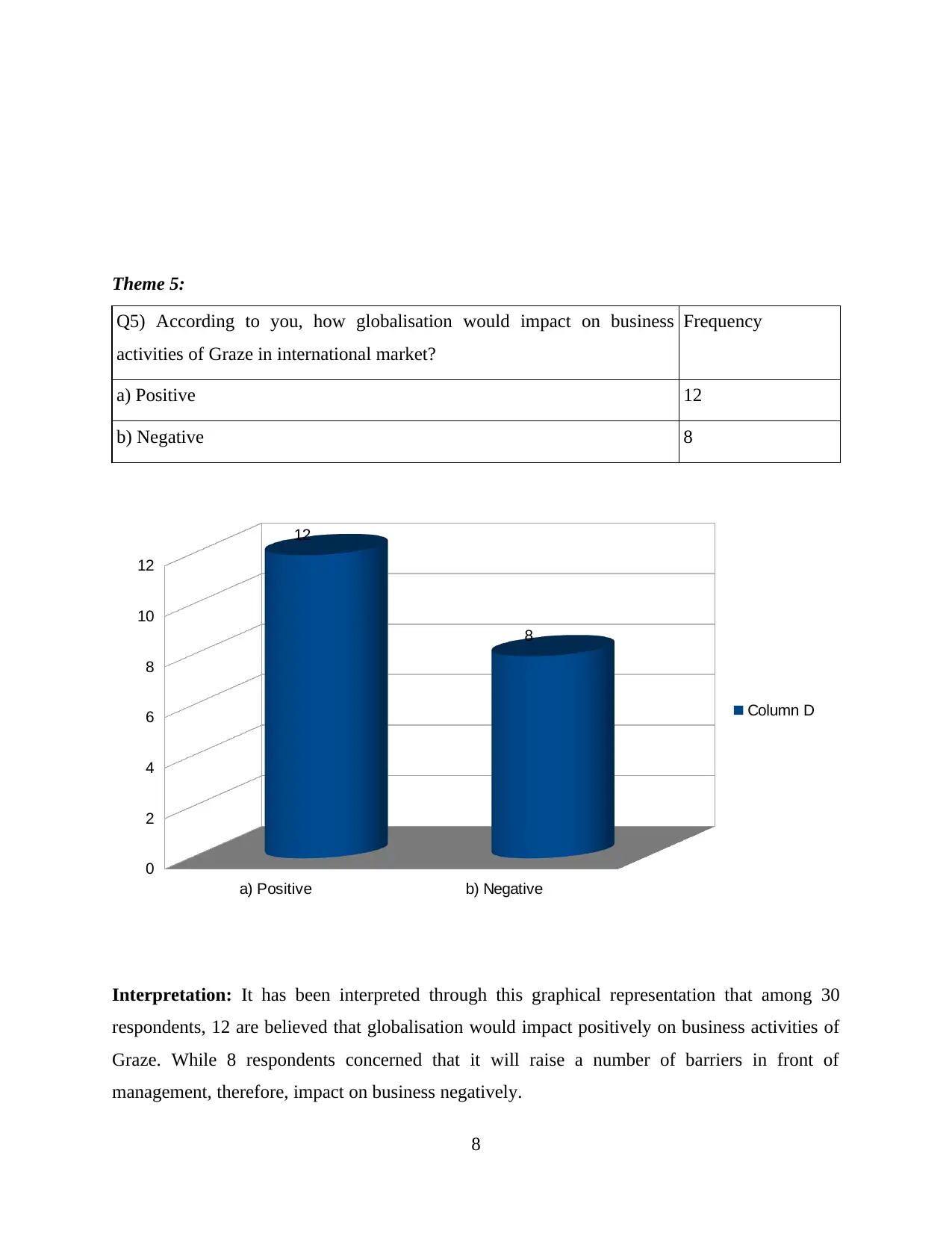
Theme 5:
Q5) According to you, how globalisation would impact on business
activities of Graze in international market?
Frequency
a) Positive 12
b) Negative 8
Interpretation: It has been interpreted through this graphical representation that among 30
respondents, 12 are believed that globalisation would impact positively on business activities of
Graze. While 8 respondents concerned that it will raise a number of barriers in front of
management, therefore, impact on business negatively.
8
a) Positive b) Negative
0
2
4
6
8
10
12
12
8
Column D
Q5) According to you, how globalisation would impact on business
activities of Graze in international market?
Frequency
a) Positive 12
b) Negative 8
Interpretation: It has been interpreted through this graphical representation that among 30
respondents, 12 are believed that globalisation would impact positively on business activities of
Graze. While 8 respondents concerned that it will raise a number of barriers in front of
management, therefore, impact on business negatively.
8
a) Positive b) Negative
0
2
4
6
8
10
12
12
8
Column D
Paraphrase This Document
Need a fresh take? Get an instant paraphrase of this document with our AI Paraphraser
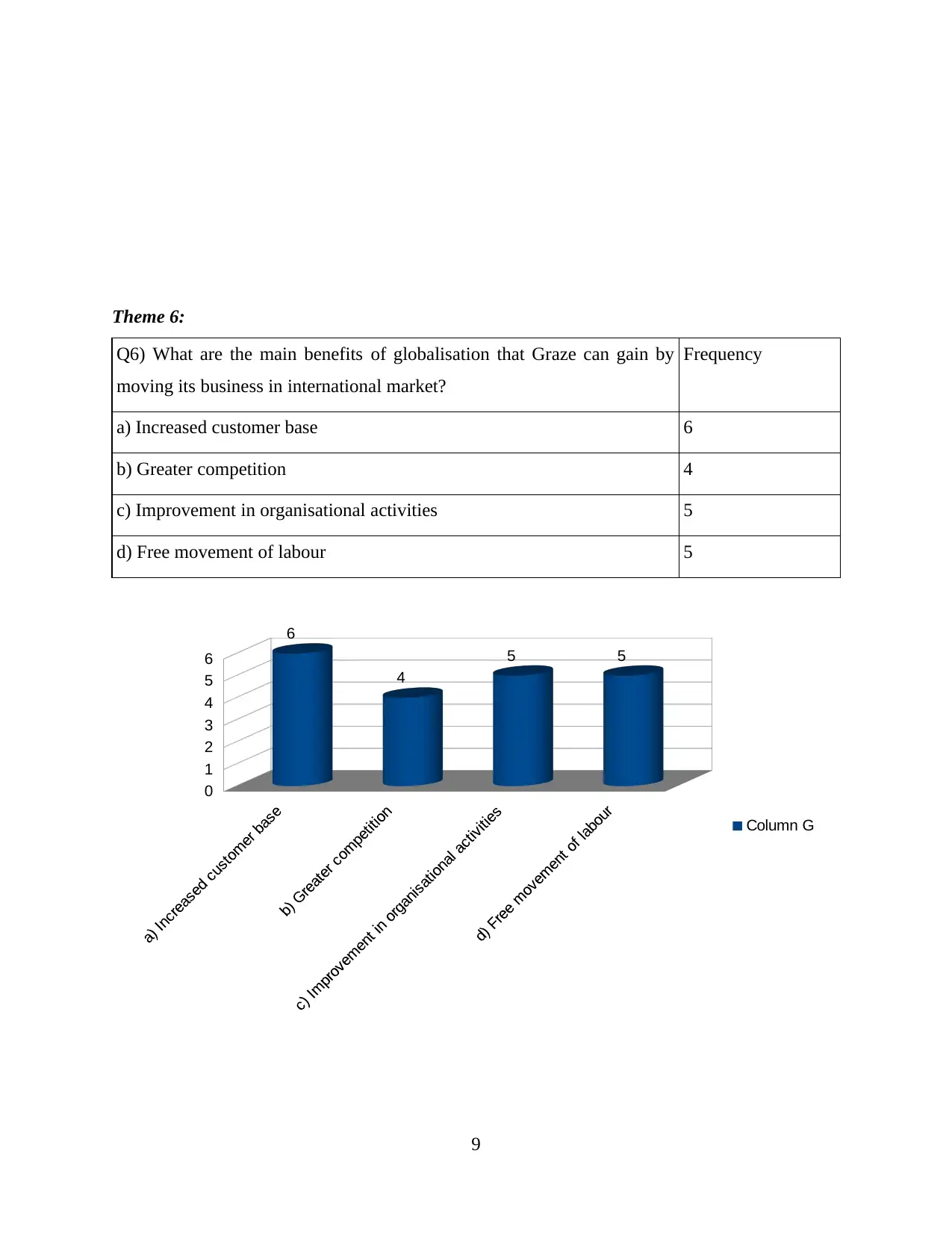
Theme 6:
Q6) What are the main benefits of globalisation that Graze can gain by
moving its business in international market?
Frequency
a) Increased customer base 6
b) Greater competition 4
c) Improvement in organisational activities 5
d) Free movement of labour 5
9
0
1
2
3
4
5
6
6
4
5 5
Column G
Q6) What are the main benefits of globalisation that Graze can gain by
moving its business in international market?
Frequency
a) Increased customer base 6
b) Greater competition 4
c) Improvement in organisational activities 5
d) Free movement of labour 5
9
0
1
2
3
4
5
6
6
4
5 5
Column G
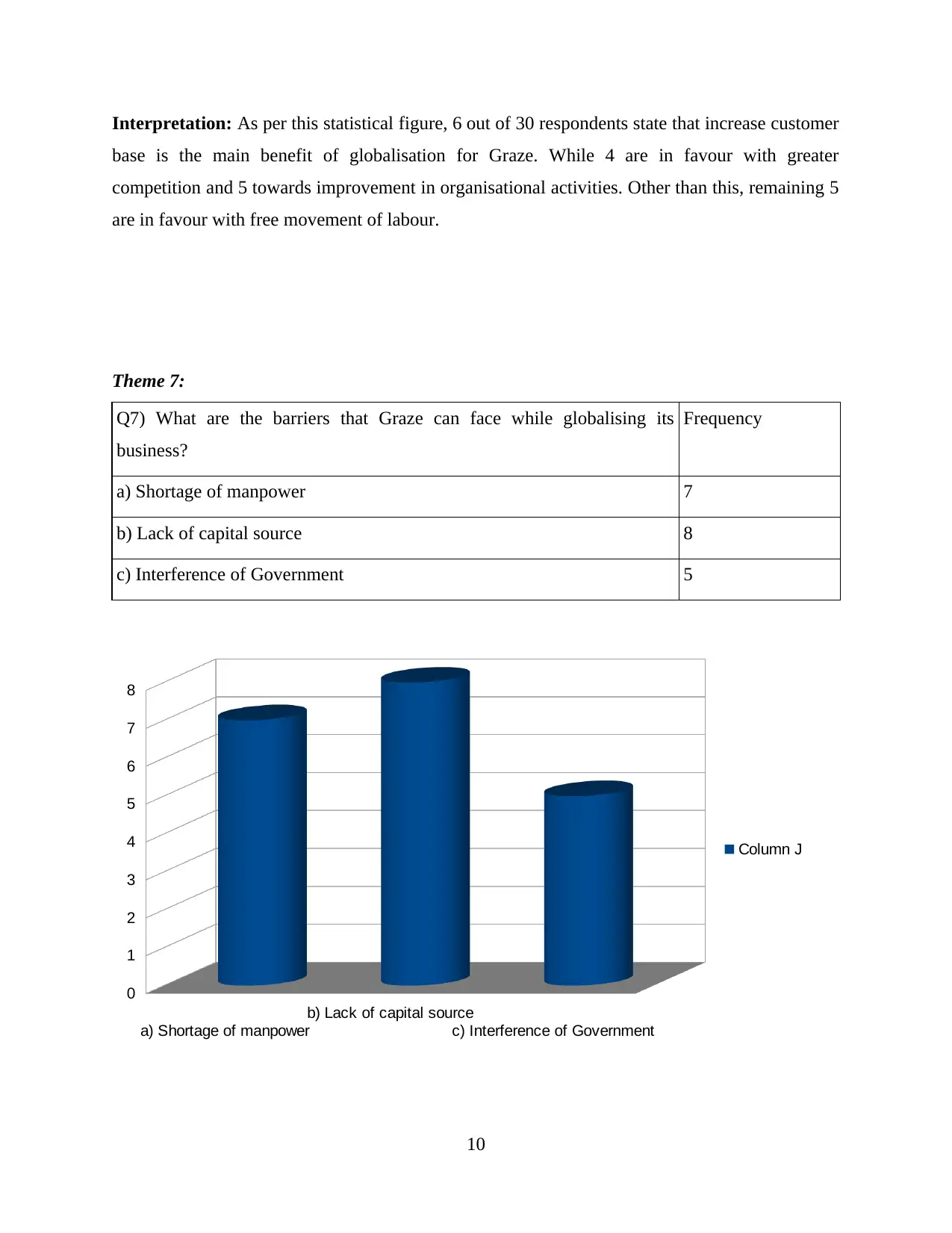
Interpretation: As per this statistical figure, 6 out of 30 respondents state that increase customer
base is the main benefit of globalisation for Graze. While 4 are in favour with greater
competition and 5 towards improvement in organisational activities. Other than this, remaining 5
are in favour with free movement of labour.
Theme 7:
Q7) What are the barriers that Graze can face while globalising its
business?
Frequency
a) Shortage of manpower 7
b) Lack of capital source 8
c) Interference of Government 5
10
a) Shortage of manpower
b) Lack of capital source
c) Interference of Government
0
1
2
3
4
5
6
7
8
Column J
base is the main benefit of globalisation for Graze. While 4 are in favour with greater
competition and 5 towards improvement in organisational activities. Other than this, remaining 5
are in favour with free movement of labour.
Theme 7:
Q7) What are the barriers that Graze can face while globalising its
business?
Frequency
a) Shortage of manpower 7
b) Lack of capital source 8
c) Interference of Government 5
10
a) Shortage of manpower
b) Lack of capital source
c) Interference of Government
0
1
2
3
4
5
6
7
8
Column J
⊘ This is a preview!⊘
Do you want full access?
Subscribe today to unlock all pages.

Trusted by 1+ million students worldwide
1 out of 20
Related Documents
Your All-in-One AI-Powered Toolkit for Academic Success.
+13062052269
info@desklib.com
Available 24*7 on WhatsApp / Email
![[object Object]](/_next/static/media/star-bottom.7253800d.svg)
Unlock your academic potential
Copyright © 2020–2025 A2Z Services. All Rights Reserved. Developed and managed by ZUCOL.





